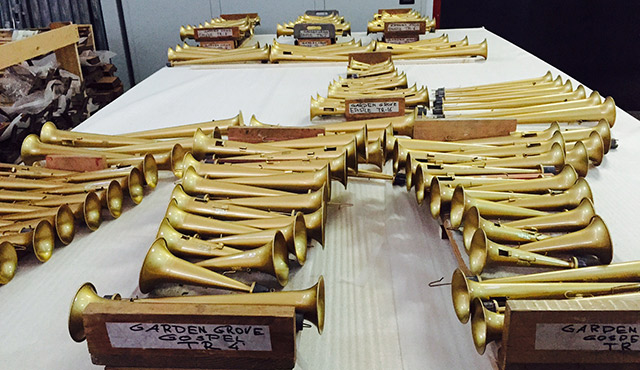Visitors walking around in the cavernous interior of Christ Cathedral these days may notice something decidedly uncharacteristic about the place the instant they stop walking: silence. Which is almost eerie considering that only weeks ago there was something in there that could make enough noise to shatter glass.
Today, however—and probably for another year or more—the enormous Hazel Wright Memorial Organ that filled the cathedral with its thunderous voice for 35 years is getting a much-needed rehab job at the hands of some of the finest craftsmen in their field. The major part of the huge and hugely complex instrument is sitting disassembled and in thousands of pieces at the Fratelli Ruffatti factory in Padua, Italy. It eventually will come back together as an immense and cohesive whole, reformed, refitted, gleaming and better than new, ready to take its place among the great pipe organs of the world.
In the meantime, tens of thousands of items, from the most intricate metal tubes that will imitate the sound of the flute to the massive multi-keyboard console with its eye-popping array of stops that control the organ’s voice, are being given new life by techniques new and old.
“It’s an herculean task,” says Monsignor Art Holquin, the chair of the subcommittee for organ restoration of the Architecture and Renovation Committee for the Christ Cathedral campus. “The technicians are dealing with nearly 16,000 individual pipes of all sizes and a console that is one of the largest in the world. Fortunately the Ruffatti people are very skilled at this. They’re a wonderful company and they were responsible for the installation of the original Hazel Wright organ.”
The organ, Monsignor Holquin explains, is actually an amalgam of three instruments: the original organ from the Arboretum on the Christ Cathedral campus, which was built by Ruffatti and is now greatly enlarged, “plus a few thousand pipes from a grand instrument from Bovard Auditorium at USC, as well as the great organ that was originally in Lincoln Center for the Performing Arts in New York.”
The parts from the latter two organs—both manufactured in the United States by the Aeolian-Skinner Organ Company—are being restored closer to home, in Orange, by the renowned organ technician Brian Sawyers.
Organs are made by hand, says Monsignor Holquin, and much of the restoration work is done in the same way: using hand tools on a workbench. And those hands need to undo a lot of damage, caused in large part by more than 35 years of conditions particular to the unique structure of the cathedral.
“The interior of the cathedral, as grand and magnificent as it is, had no temperature control,” says Monsignor Holquin. “So everything inside was totally at the mercy of cranking open some of the lower windows or the great window that was situated behind Dr. Schuller. Temperature variances in the summer could range from above 80 degrees at the floor level to above 105—some have even said 110 degrees—at the upper reaches of the cathedral. And anybody who knows anything about pipe organs knows that stability of temperature is so critically important. After 35 years of those types of temperature fluctuations, there were major problems with the pipe work. Not to mention the fact that when those doors were open and the outside air came in, oxidation occurred on a number of the pipes.”
Those pipes are “in the process of being brought back into pristine condition,” says Monsignor Holquin. The pipes from the upper galleries, shaped like the bells of trumpets, are expected to be particularly spectacular.
“They were done in a brass material,” says Monsignor Holquin, “and they were dark and pitted and in very bad shape when they were taken out. They’ll be coming back with brilliant color as well as brilliant sound.”
The general sound quality of the instrument will be improved, in part by the replacement of 35-year-old electronic technology with the latest in state-of-the-art equipment, much of it controlled at the console.
“The console controls the entire instrument,” says Monsignor Holquin, “and all its inner workings are being brought into the most modern condition. That will facilitate the playing of the instrument by some of the great organists who will be coming in. The stop action will be quicker and more effective. And there will be a wonderful new feature that will allow the organist to play the carillon that’s in the cathedral tower. There will also be an app that will allow the carillon to be played from an iPad.”
When the organ parts are returned to the cathedral, some of the most exacting work then begins: the re-installation of the entire instrument and “the great work of what they call voicing and re-scaling the pipes to conform to the new sound of the cathedral, and that will take months,” says Monsignor Holquin. The re-installation, he adds, “needs to be done when virtually everything else has been completed in the cathedral. It’s the last thing to be done because it has to be in a relatively dust-free environment. There can’t be any construction going on.”
The good news: the restoration is currently ahead of schedule and the gleaming organ should be re-installed in Christ Cathedral by the middle of 2017, says Monsignor Holquin.
More good news: the wildly fluctuating temperatures that bedeviled the original organ will be greatly modified by new cathedral “temperature controls that will be able to moderate temperature variances by not opening those windows,” says Monsignor Holquin. “So the organ will be kept in pristine condition for a much, much longer time.”

